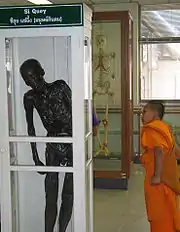Si Ouey
Si Ouey or Si Uey Sae-Ung (Thai: ซีอุย แซ่อึ้ง, RTGS: Si-ui Sae-Ueng, Thai pronunciation: [sīː.ūj sɛ̂ː.ɯ̂ŋ]), commonly spelled Si Quey and whose actual name was Ng Lihui (Chinese: 黃利輝; pinyin: Huáng Lìhuī), was a Sino-Thai gardener who became best known as a convicted serial killer. Si Ouey allegedly killed several children throughout the 1950s before being arrested in 1958 and executed in 1959. According to some sources, Si Ouey was the first serial killer in the history of modern Thailand.

Biography
Much of Si Ouey's history is unknown; the Thai department of corrections was never contacted by a family member, and as of 2020 Si Ouey was considered stateless. One source states that Si Ouey was born in Shantou, China in 1927, and that he later fought during the Second Sino-Japanese War. According to Thai government records, Si Ouey engaged in cannibalism during the war, eating parts of his fellow soldiers when supplies ran low during a siege.[1] He emigrated to Thailand after the war.[1]
During the 1950's, Si Ouey worked in a number of menial roles (several sources describe him as a gardener) before beginning his killings. From 1954 to 1958, Si Ouey killed several (sources disagree on whether four,[2] five,[2] or six[1]) Thai children, allegedly disemboweling, boiling, and eating his victims. Active in Bangkok, Nakhon Pathom, and Rayong, Si Ouey was arrested (reportedly while attempting to burn a body)[3] by Thai police in 1958 after which he confessed to the murders. According to Thai records, Si Ouey confessed to police that he targeted children as they were easier to lure. He also allegedly admitted to enjoying the taste of human flesh, but later denied being a cannibal.[1][4] He was tried, sentenced to death, and executed by firing squad in 1959 at the age of 32. Si Ouey's remains were preserved and used for medical testing before being embalmed and put on display Siriraj Medical Museum in Bangkok.[5]
While most sources state that Si Ouey committed the murders, others have called into question his confession and trial.[6] Several note that Si Ouey spoke no Thai and as such may not have given an accurate confession, and that he was forced to use a translator during his trial.[7][1] Anti-Chinese and anti-immigrant sentiment may have also played a roll in Si Ouey's trial.[1] A campaign by humanitarian activists successfully campaigned for Si Ouey's corpse to be removed from display in August 2019, and in July 2020 his remains were cremated at Wat Bang Phraek Tai temple.[7]
See also
References
- Krausz, Tibor (2019-06-14). "Could serial child killer and cannibal Si Quey, bogeyman for Thai children, have been an innocent scapegoat?". South China Morning Post. Retrieved 2020-09-08.
- "Si Quey, Exonerated of Cannibalism, is Laid to Rest (Photos)". Khaosod English. 2020-07-23. Retrieved 2020-09-08.
- "Mörder im Glaskasten: Thailand streitet über Leichnam im Museum". HAZ – Hannoversche Allgemeine (in German). Retrieved 2020-09-08.
- Martinus, Danial (2020-07-21). "A 'cannibal' who murdered seven kids is finally being cremated after more than 60 years". Mashable SEA. Retrieved 2020-09-08.
- Laohong, King-oua. "Cannibal killer Si Quey to be cremated". Bangkok Post. Retrieved 2020-09-08.
- Tassanee, Vejpongsa; Peck, Grant (23 July 2020). "Thai serial killer cremated after decades as museum display". AP News. Retrieved 9 September 2020.
- Laohong, King-oua. "Serial killer Si Quey cremated". Bangkok Post. Retrieved 2020-09-12.